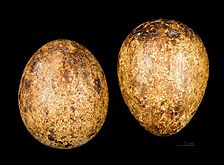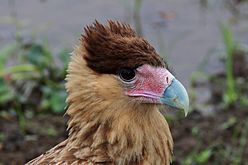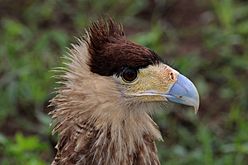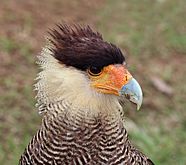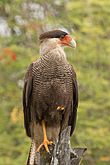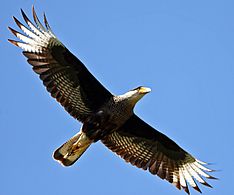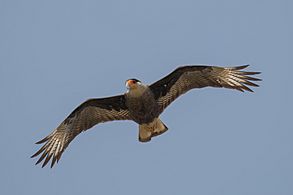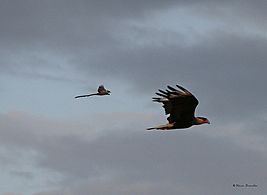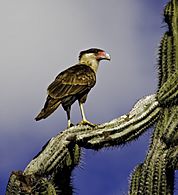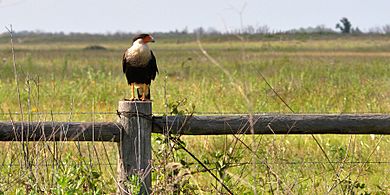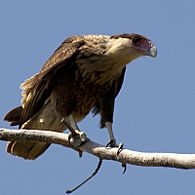Mexican eagle facts for kids
Quick facts for kids Crested caracara |
|
|---|---|
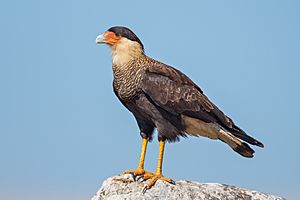 |
|
| An adult crested caracara in Serra da Canastra National Park, Brazil | |
| Conservation status | |
| Scientific classification | |
| Genus: |
Caracara
|
| Species: |
plancus
|
| Synonyms | |
|
Polyborus plancus |
|
The crested caracara (Caracara plancus) is a fascinating bird of prey. It belongs to the Falconidae family, which also includes falcons. This unique bird is found in many places. You can see it in South America, Mexico, and Central America. It also lives in the southern United States, including Florida. Sometimes, it even travels much farther north! People have spotted it in places like California and even Canada.
Contents
What Does a Crested Caracara Look Like?
The crested caracara is a medium-sized bird. It measures about 50 to 65 centimeters (20 to 26 inches) long. Its wings can spread wide, from 120 to 132 centimeters (47 to 52 inches). This bird usually weighs between 0.9 and 1.6 kilograms (2 to 3.5 pounds).
Caracaras from colder areas are often larger. They are the second-largest type of falcon in the world by weight. Only the gyrfalcon is bigger!
This bird has dark brownish feathers on its head, belly, and most of its wings. The feathers around its ears, throat, and neck are whitish. Its chest and back have whitish stripes with dark brown. When it flies, you can see a big light patch on its outer wing feathers. This patch looks like a "window." Its legs are yellow. The skin on its face and around its beak is bright yellow to reddish-orange.
Young caracaras look a bit like adults. However, they are lighter in color. They have stripes on their chest and neck. Their legs are grey, and their facial skin is whitish or pinkish.
Behavior and Life Cycle
The crested caracara is a bold and clever raptor. It often walks on the ground to find food. It mostly eats dead animals, like a scavenger. But it's also a bit of a thief! It will steal food from other birds of prey. It also raids bird nests to eat eggs or chicks.
If it gets the chance, it will hunt live prey. This usually means insects or small animals. It can even catch birds as big as a snowy egret. Caracaras are stronger than black and turkey vultures. This means they get to eat first at a carcass. They also follow wildfires or farm equipment. These events can scare out small animals, making them easy prey.
Caracaras are usually found alone. But if there's a lot of food, like at a dump, several might gather together.
Reproduction
Crested caracaras build large, open nests. They usually place their nests at the top of a tree or palm. Sometimes, they even build nests on the ground. The female usually lays two eggs. In warmer places, they can breed at any time of year. In colder southern areas, they breed in the spring and summer.
-
Being mobbed by a fork-tailed flycatcher
-
Young adult perched on a cactus, Bonaire, BES Islands
-
Northern crested caracara (Caracara cheriway), Attwater Prairie Chicken National Wildlife Refuge, Colorado County, Texas, USA
Where Crested Caracaras Live
The crested caracara lives in a wide range of places. You can find it from the very south of South America up to the southern United States. It also lives in Mexico and Central America. There's even a group of them living on the Falkland Islands.
These birds do not like high mountains like the Andes. They also avoid thick, wet forests, such as the Amazon rainforest. Instead, they prefer open or partly open areas. They are often seen near people.
The Florida Caracara
Florida has a special group of northern caracaras. They have lived there since the last ice age, about 12,500 years ago. Back then, Florida was covered in open grasslands. As the Earth got warmer, these grasslands disappeared in many places. But caracaras survived in Florida's prairies and marshes.
They like to build nests in cabbage palmetto trees. They also use southern live oaks. Historically, they lived in many counties in central Florida. Today, they are most common in DeSoto, Glades, Hendry, Highlands, Okeechobee, and Osceola counties.
Sadly, the number of Florida caracaras went down. This happened because they lost their natural homes. So, in 1987, the United States Fish and Wildlife Service listed them as a "threatened" species. This means they need protection to survive.
Crested Caracara in Mexico
The crested caracara is very important in Mexico. An expert on birds, Rafael Martín del Campo, thought this bird was the "eagle" shown in ancient Aztec drawings. These drawings are found in old books called Aztec codices.
This image of an eagle became a national symbol for Mexico. You can see it on the Mexican flag and other important places. Even though the drawings were later thought to show a golden eagle, the caracara's image is still a big part of Mexico's history.
Status of the Species
The crested caracara is quite common in most places where it lives. In fact, it might even benefit from forests being cut down in tropical South America. This is because it prefers open areas. Because of its large numbers, BirdLife International considers it a species of "Least Concern." This means it is not currently at risk of disappearing.
Images for kids
-
An adult in Panama Viejo, Panama foraging for food.
See also
 In Spanish: Caracara plancus para niños
In Spanish: Caracara plancus para niños



